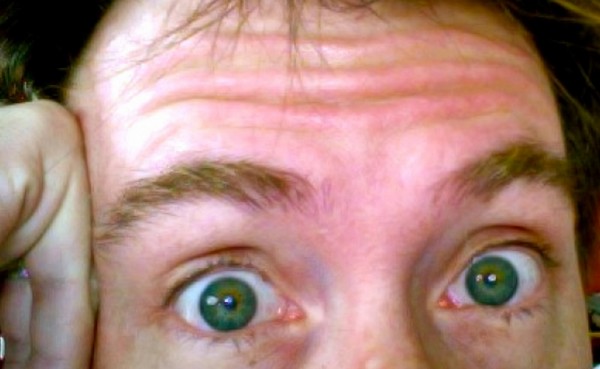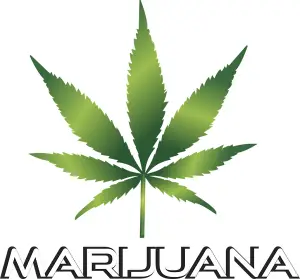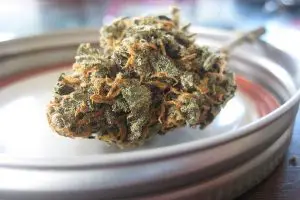Random Things You Probably Don’t Know About THC
DISCLOSURE: As an Amazon Associate, I earn from qualifying purchases.
Clearly, most people who visit a site like this have at least a rough idea what THC is – well enough to choose the best strain, based on THC concentration. 😉
But unless you’ve recently faced a drug test for marijuana, you may not have looked that hard at what THC (∆9-tetrahydrocannabinol), the main psychoactive chemical compound in weed, actually is.
If you did get tested, though, I bet you scrambled FAST to learn exactly what THC is and how to get it out of your system, as quickly as possible!
After a ton of questions, I finally decided to spend some time going deep and learning everything I could about the safest illicit drug known to man.
And I learned a bunch of stuff that you likely don’t know about THC.
Some of these are shockers, and others are just mildly interesting facts you can use to impress your friends.
Which ones are you familiar with?
It’s Highly Volatile
Technically, THC is a fat molecule.
That’s part of the reason it makes its home among the fat cells in your body (including in your brain) when you use marijuana.
It is highly soluble in other lipids, too.
When isolated, THC appears as a viscous oil with high volatility. It reacts (decomposes) quickly when exposed to air, light or heat. In fact, if you go to a lab where they have isolated THC, you’ll find it mixed with organic solvents and stored in dark glassware.
It is its fatty nature that makes marijuana remains in your system for so long, far longer than most other drugs.
When you inhale or ingest cannabis, THC and other cannabinoids are quickly moved from the blood stream to your fat cells where they tend to stick around for long.
That’s why a blood test can only detect THC after only a few hours or a day of using weed. But a urine test, which tests for metabolites released from your fat cells, can detect usage after 30 days and sometimes even longer in heavy users.
We’ve Been Using THC For At Least 3,000 Years
Raphael Mechoulam, an Israeli scientist, is credited with discovering, isolating and synthesizing THC between 1964 and 1970. His identification and isolation of the active compound in marijuana allowed other researchers to study the herb and its effect on users better.
The full story on how he went about his research is quite interesting, especially the fact that he had to illegally obtain weed from the police station to study it.
His efforts have been rewarded with numerous accolades, including an honorary doctorate from Ben-Gurion University in 2013.
What you may not know is that people discovered the psychoactive effects and medical benefits of THC and other weed cannabinoids several millennia before Raphael Mechoulam started his work.
Traces of cannabis use have been found in the remains of cultures living as early as 10,000 BC.
There are numerous verified accounts of communities dating back thousands of years, who apparently used cannabis to treat diseases, as a pain killer or simply to get high.
Of course, none of them had an inkling about the molecule, THC.
All they knew was that they had found a herb that worked wonders on pain, diseases, and stress.
THC Affects Adults and Teens Differently
In the modern era, weed has mostly had a negative perception among the public and government officials. It is only in recent years that various states in the US have legalized it.
One of the main reasons for the opposition is concern about adverse effects on users.
A raft of studies has, however, eased concerns that THC is detrimental to mental or physical health.
If anything, they have discovered even more health benefits of cannabis.
But it’s not all good news.
Health benefits and low risk of adverse effects were only true in adults.
When researchers looked at the effects of THC in teenagers (below 17 years), the results were quite worrying. One study showed that teenage smokers performed poorly on cognitive tests and had higher high school dropout rates.
This is because marijuana interacts with the brain at a period when it is still actively developing, unlike in adults when brain growth has slowed down. THC and other cannabinoids physically alter the structure of the brain, affecting regions associated with memory, problem solving and cognition.
None of these adverse effects are seen in adult smokers. That’s why experts advise teenagers to avoid weed until years later when it is unlikely to cause any havoc on their mental capacity.
You Have Evolution to Thank for Getting High
The therapeutic and psychoactive effects of THC are only possible because of the endocannabinoid system (ECS) in your body.
This system contains Cannabinoid receptors that are activated by THC when you smoke or ingest weed.
Specifically, THC binds to the CB1 receptor which results in the high you experience. And because these receptors are found in different parts of the body and different quantities, one person may experience different smoking side effects from another.
Some may experience an increase in appetite; others lose motion control while others become more mentally active and tend to concentrate better. Additionally, someone with more CB1 receptors than average will be more sensitive towards THC.
The ECS is not there just to help you get high, though.
It evolved over half a billion years ago, before cannabis or mammals existed.
It exists in organisms as basic as sea squirts and nematodes. ECS developed to help different body systems – the nervous system, brain, immune system, etc. – communicate and work together.
This interaction between systems through ECS is enabled by the production of the body’s natural cannabinoids.
They bind to various receptors in the ECS, creating a wide variety of effects related to pain, emotions, creativity and overall health.
Thanks, Darwin!
THC is Used to Treat Many Medical Conditions
Marijuana is currently enjoying a boost in popularity even among local governments.
One big reason for this is recent research showing the many health benefits of THC and other cannabinoids in weed.
Variants of the THC compound are even used in pharmaceutical drugs to treat the issue like nausea in patients undergoing chemotherapy.
Over time, research continues to uncover more conditions that can be treated or managed by smoking or ingesting marijuana.
One of the most surprising is Anorexia.
Anorexia, it has been discovered, is caused partly by changes in the endocannabinoid system. In particular, the ECS becomes less responsive to internal cannabinoids associated with reward, emotions, and appetite.
Because THC interacts directly with the ECS, it can help make things right again. For one, it increases the pleasure experienced from food. This kick starts your reward system, making it easier to eat more food without feeling guilty or purging.
THC can also help boost your metabolism and appetite by triggering the production of the hunger hormone, ghrelin.
Apart from anorexia, THC has been shown useful in mitigating inflammation, cancer (it kills cancer cells), dementia (reduces inflammation in the brain), stress, low appetite, and nausea.
You may have heard from certain sources that Cannabidiol (CBD), a non-psychoactive cannabinoid in weed, is the only one that holds medicinal benefits. But that is not true. Recent research has proven that THC also has numerous health benefits. When combined, CBD and THC can offer even more therapeutic results.
You Poop Most of the THC Out Of Your System
Most weed smokers know only about the THC that comes out through urine; the one that labs test for.
But actually, more than 65% THC in your system gets out through your poop. Less than 20% gets out through urine.
When you smoke or ingest weed, it gets into your bloodstream and is stored mostly in your fat cells.
Over time, small bits of THC metabolites are released back into the blood. Some of it ends up in your urine, but most of it comes out with feces.
Based on this, some weed users hoping to beat a drug test quickly use fruit pectin, a type of fiber. It makes you poop more often, theoretically forcing more THC out of the body.
The effectiveness of this method is limited – and questioned by many.
Marijuana is Not the Only Source of Cannabinoids
Marijuana is the best-known source of cannabinoids, but it is not the only one.
Other plants have been discovered to contain their THC-like cannabinoids. Some of these plants are even used in medicinal applications.
Examples include Coneflower (treats the common cold, anxiety, migraines etc.), Liverwort which has a cannabinoid very similar to THC (treats bronchitis, liver and gallbladder problems) and Electric Daisy (contains powerful anti-inflammation and pain-killing cannabinoids).
Uber-expensive black truffles also contain compounds that the body uses to create anandamide, a natural look-alike to THC produced naturally by the body.
There are also some early attempts to synthesize THC from genetically engineered yeasts. This would make the production of THC-based medications easier and cheaper.
Nature is packed full of healing compounds. Weed is better known than others because of its psychoactive properties.
You Don’t Have to Use It to Test Positive for THC in Your Hair
Of all the different types of marijuana drug tests, the hair follicle test (click for our FAQ sheet) is the most dreaded.
This is because THC tends to stick around in hair far longer than any other part of the body.
A hair sample can contain traces of THC you used months ago, as long as you have not shaved.
It is also much harder to beat a hair test compared to a urine or blood test. Shaving your hair, the most effective method to get rid of THC will invite immediate suspicion.
Some products can clean THC from your hair but they may not work for everyone and carry the risk of damaging your hair.
Of course, there is no reason to worry if you don’t smoke weed or eat any foods with weed. Right?
Unfortunately, there is a chance, though small, that your hair could test positive for THC even if you have never smoked a joint.
The most common basis for this is that THC reaches hair through the bloodstream.
A recent study cast big doubt on the idea that blood is the only source of THC in hair, though. Two study participants were given synthetic THC and tested after 30 days. Very little THC was detected in their hair.
But when hair from the pre-study period was tested, tiny traces of THC were found.
So it is possible that THC could get into your hair from the external environment. Living with people who smoke weed or touching the plant itself might introduce THC into your hair.
THC Affects Men and Women Differently
There hasn’t been much research into gender-specific effects of THC and other marijuana cannabinoids.
The little there is shows that there is quite a gap in how THC affects men and women. Factors like hormones and metabolism levels are thought to contribute to this variation.
In women increase in estrogen levels correlates with increased sensitivity to THC.
In other words, you will get a bigger high just before ovulation. Not only is the high more enhanced, THC’s pain-killing and stress-relieving effects are also felt on a higher note.
Another study showed that women tend to experience more severe withdrawal with symptoms like low appetite, and poor sleep. Another showed that weed strains with low THC concentrations could boost libido.
THC is more likely to trigger a bigger spike in appetite in men than women.
When it comes to sex drive, THC increases libido for a short amount of time just after consumption (20 minutes to an hour). After that, testosterone quickly dips below normal levels, taking your libido down with it.
THC Is One of More than 100 Cannabinoids in Weed
THC may be the most popular cannabinoid derived from weed, but it is not the only one. Since THC was isolated in 1964, scientists have been continuously discovering other cannabinoids in different strains of marijuana.
In 2015, seven new cannabinoids were isolated by researchers at the University of Mississippi. In total, we have around 111 known cannabinoids, each carrying potential health benefits.
I’m sure we will discover much more with time and in the process uncover many more interesting things about THC.

My name is Jay Wilson, but my friends call me JZ. Originally from Atlanta I now live in Denver, CO where things are ‘freer’ these days. Several years ago, I put this site up for a friend who asked me to find ways to beat his upcoming hair drug test. Fast-forward to today, I’ve answered more than 1,000 questions about the hair drug test and proven ways to beat it. I am an expert in the hair test – ask me anything!





Moumita Mallick
April 14, 2018 @ 5:04 am
Well THC is one more reason not to go into smoking. Loved this article, definitely learned something new. And it was really informative. Thanks for posting this.